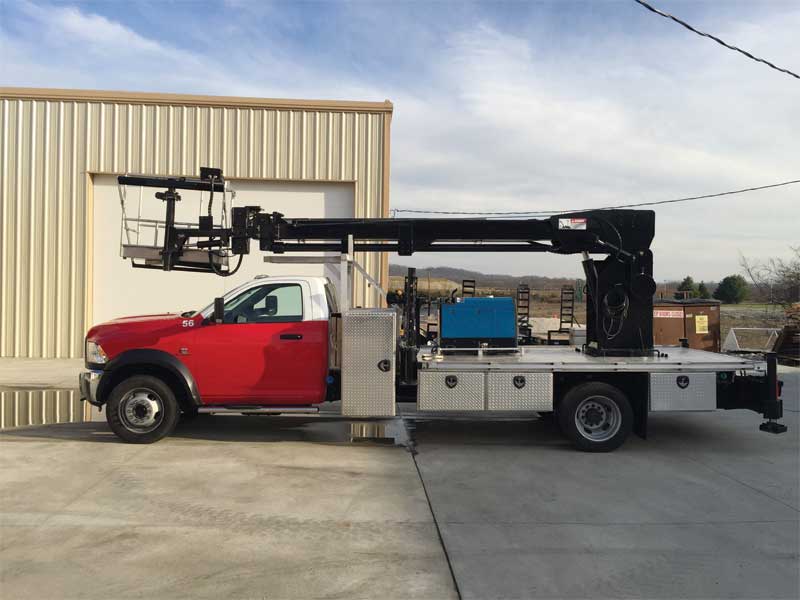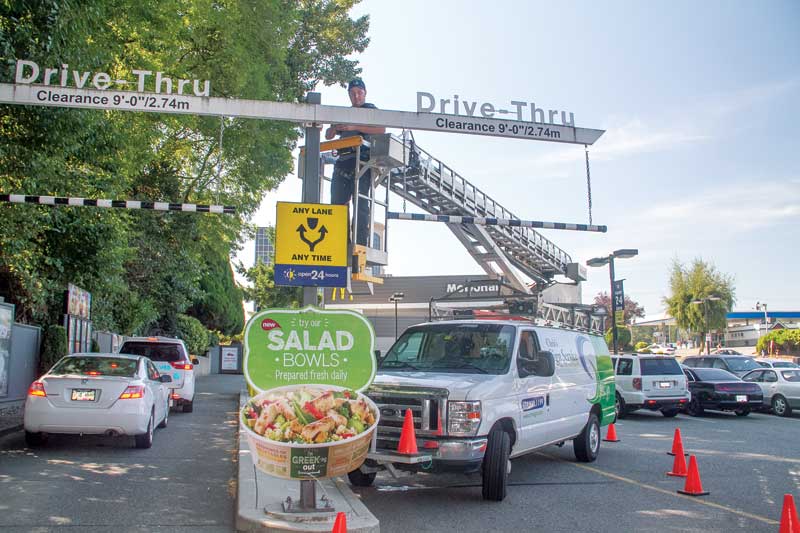
Many of today’s telescopic cranes are powered by a generator or inverter, rather than the truck’s engine. This reduces wear and tear for the vehicle.
Photo courtesy Radocy
Evolving needs
Reflecting the flexibility needed to handle a broad variety of jobs, sign companies may own and/or rent equipment to meet changing demands.
“We find sign companies typically start with renting,” says Radocy’s Bradley. “When their yearly costs increase, then they start to look at leasing or buying.”
“Some sign project management companies, like Media Resources in Oakville, Ont., own all of their trucks,” says Scott Powerline’s Gerber, “but many more sign companies subcontract out their installation work. It’s a question of capital expenditure. If you only rent, there may be times when availability is slim, which can be a problem.”
“We find there are mainly two types of companies,” says Dennis Hansen, co-owner of Van Ladder, which started out serving telephone utility companies in 1968, before branching into the sign industry. “There are those that do their own installations and have a dedicated bucket truck and a full-time trained and certified driver. Then there are those that focus more on manufacturing signs and only use smaller service vehicles, which is where we come in.”
As its name suggests, Van Ladder manufactures energy-efficient single-operator aerial buckets that can be mounted to midsized service vehicles. They offer 360-degree rotation, a working height of 14 m (45 ft) and side reach of 9 m (29 ft), which is suitable for many regional sign maintenance providers’ typical day-to-day needs.
Chris’s Sign Service, for example, has upgraded its fleet in recent years from vans with 10-m (34-ft) aerial ladders to the 14-m Van Ladder line, which meets most of its needs for retrofitting, servicing and maintaining electric signs in British Columbia.
“We’ve slowly replaced our shorter lifts with the longer-reach products,” says Kevin Balzer, general manager (GM). “Today’s lifts are aluminum, which makes them lighter, so we can more easily put a longer-reach ladder on our vans, without needing outriggers; this speeds up service time and, in turn, saves money for the customer. For one of our recent jobs, we had to rent a truck-mounted crane to install a heavy Best Buy sign, but we were then able to reach it with our regular ladders. And nearly 98 per cent of our work these days is maintenance, which we can handle with the ladders. We rarely need to rent a lift to reach any higher for a job.”

A compact vehicle with a short wheelbase is particularly helpful when installing a sign in a parking lot with lots of cars.
Photos courtesy Chris’s Sign Service
No universal lift
Toronto Sign Services, which specializes in installing wide-format printed vinyl graphics, also uses scissor and boom lifts, but can eschew trucks due to the nature of its work.
“We almost never deal with electrical signage, so trucks are not useful to what we do,” says Alex Severin, owner. “We use scissor lifts about 80 per cent of the time. In other cases, we use articulating and telescoping boom lifts. And we rarely need more than one at a time for a job.”
Given the variety of models of lifts needed for different jobs, Toronto Sign Services rents them, rather than buying.
“There is no ‘universal’ lift we could use,” Severin explains. “Some companies can buy
a scissor lift that will accommodate about 70 per cent of their work, but we rent because we need something different for every job, based on where we’re working.”
Indeed, Toronto Sign Services starts with detailed information about an installation job—including a site survey, height measurements, access details and photos from the client—before determining which equipment to rent for the occasion.
“Given I’ll be working on the equipment, I need to make sure I’ll be comfortable and safe,” says Severin, who recently became the first Canadian graphics installer to be master-certified by the Professional Decal Application Alliance (PDAA), part of the Specialty Graphic Imaging Association (SGIA). “We wrapped a passenger jet worth millions of dollars, for example, so we couldn’t cut graphics on it—they all had to be pre-cut—and we needed an extended platform to get to hard-to-reach areas.”
Another benefit of renting lifts is avoiding liability issues. When Severin shows up for a job, the equipment has already been dropped off by the supplier, so he is not responsible for bringing it to the work site without damaging anything around it.





